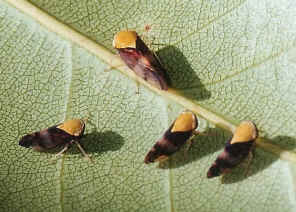Order
Hemiptera
This page contains pictures and information about Cicadas,
Spittle Bugs, Treehoppers, Leafhoppers and Planthoppers
that we found in the Brisbane area, Queensland, Australia.

The former suborder Homoptera has been divided into two suborders. This suborder Auchenorrhyncha
includes cicadas, spittle bugs, treehoppers, leafhoppers and
Planthoppers. Hoppers
have hard forewings which held roof-like over the membranous hind wings on
the back.
All members in this suborder, except cicadas, have characteristic
spinose hind legs and they jump, i.e., their common name - hoppers.
Classification :
In the Suborder Auchenorrhyncha, the Cicadas family Cicadidae is a famous family. The other families in this suborder are less known. They
include the Planthoppers, Tree hoppers and Leaf hoppers.
Superfamily CICADOIDEA
Cicadas are well known because their 'song' is the back ground
noise here in summer. Their empty shells often seen on tree trunks and
fences. The young nymphs live underground suck the roots of trees.
They may live underground for years, come up from soil in summer, have the
final moulting and leave those empty shells. This is the male who sing the
song to attract female. Each species have different 'songs'.
Superfamily CERCOPOIDEA
Their nymphs produce 'spittle' clinging to the stems of shrubs or small
trees to reduce the risk of dehydration or to deter parasites. Those spittle
is sometimes known as cuckoo-spit. When carefully removed those
'spittle', we saw an insect nymph hiding inside.
Superfamily MEMBRACOIDEA (CICADELLOIDEA)
They are small, plants feeding insects ranging in colour from green,
through yellow-green to brown. They can be found on tree trunks, stems and
leaves. They feed by sucking the sap of plants. All of them jump, so their
name hoppers. Some of their adults are active flyer.
Many species in this family are brightly coloured. Their head is relatively
flat with ocelli in the front. They often stay in groups feeding on
young stems of eucalypt. Usually there are ants around them for their
excretion of 'honey-dew', which is the excess sugar that the treehoppers do
not need.
Members in this family have the enlarged pronotum extending back over
the abdomen between wings, which gives them the bizarre looking body shape.
Many species also have the pronotum extending forward so that they are
horned. Some may mimic thorns on their host plant.
The Superfamily FULGOROIDEA contains large number of very diverse forms.
All of them are strong jumpers, and are generally known as Planthoppers.
Their antennae situated beneath eyes. Wax plates common in females for
producing wax to cover eggs. The nymphs usually have two long tails. Click
on here
to see all we found about Superfamily FULGOROIDEA.
- Reference and links:
- 1. Insects
of Australia, CSIRO, Division of Entomology, Melbourne University
Press, 2nd Edition 1991, pp 464.
- 2. Identification
Keys and Checklists for the leafhoppers, planthoppers and their
relatives occurring in Australia and New Zealand (Hemiptera:
Auchenorrhyncha). Fletcher, M.J. and
Larivière, M.-C. (2001 and updates).
- 3. MEMBRACOIDEA
- Australian Biological Resources Study, Department of the Environment and
Heritage
Back to top
[ Cicadidae ] [ Aphrophoridae ] [ Cicadellidae ] [ Membracidae ] | 
 Family Cicadidae - Cicadas
Family Cicadidae - Cicadas Family Aphrophoridae - Spittlebugs
Family Aphrophoridae - Spittlebugs

 Family Membracidae - Horned Treehoppers
Family Membracidae - Horned Treehoppers